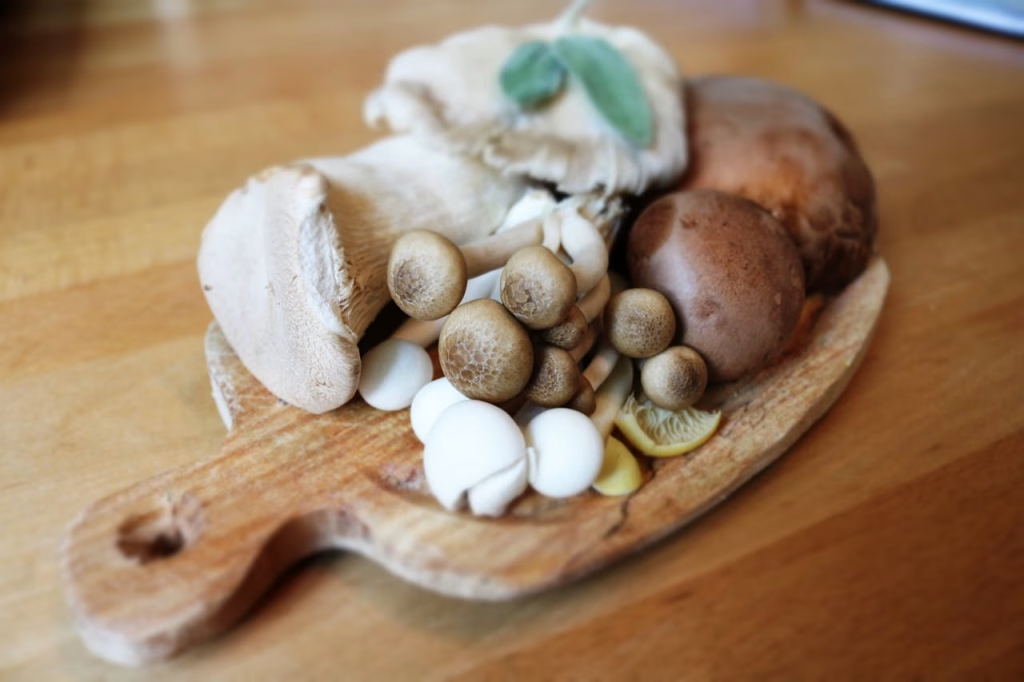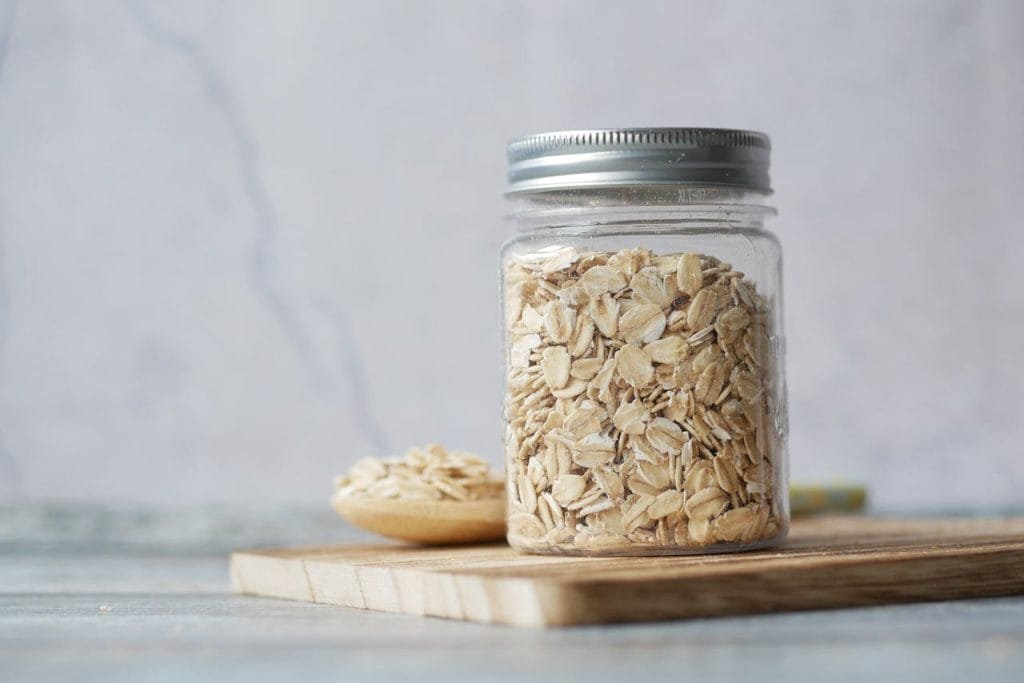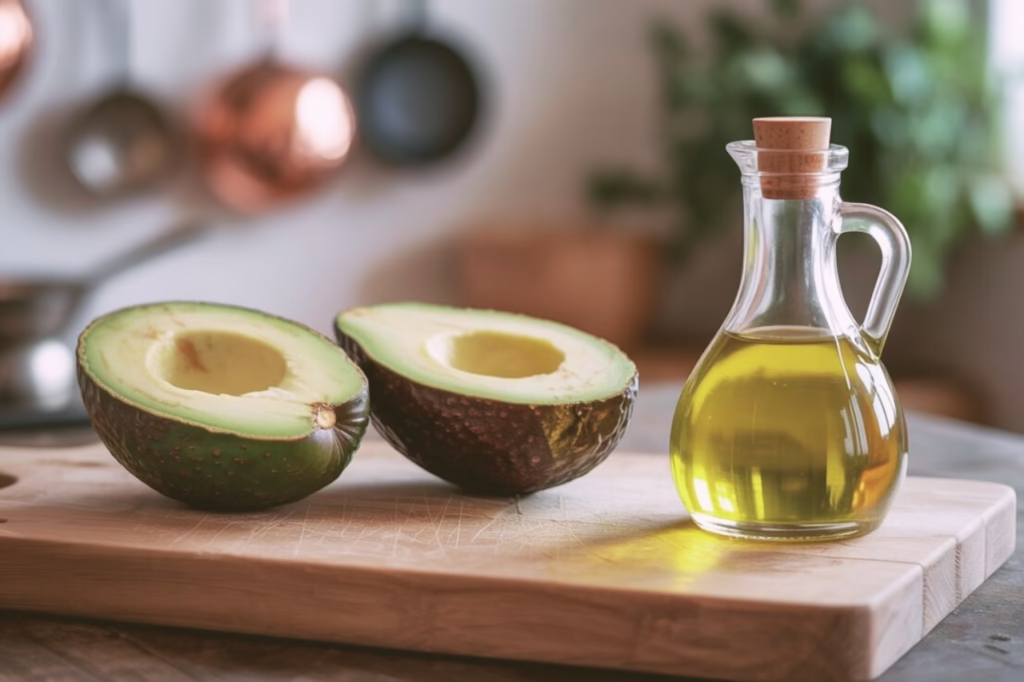Whether you love or hate them, mushrooms are one of the most nutritious foods on the planet. There are around 70,000 species of mushrooms worldwide, and over 2000 species are edible. Mushrooms are used as food and medicine in various cultures, but five mushrooms are the most popular in the Western world at the moment: Shiitake, Lion’s Mane, Portobello, White Button, and Oyster.
This article provides a detailed breakdown of mushroom nutrition facts, calories, and health benefits to help you understand why mushrooms should be part of your diet.
Despite their differences in taste and texture, all five mushrooms share similar nutrition and health benefits:
Mushroom Nutrition Facts:
- Low in Calories: All five mushrooms are low in calories, making them excellent food for weight management.
- Good Protein Source: They provide a substantial amount of protein helpful for muscle growth.
- Low in Fat: All mushrooms are low in fat, so perfect for heart-healthy diets.
- Rich in Vitamins and Minerals: While the specific vitamins and minerals vary (we will break them all down later), mushrooms offer a good source of nutrients like selenium and B vitamins.
- High in Fiber: mushooms contain dietary fibre, which is great for digestive health.
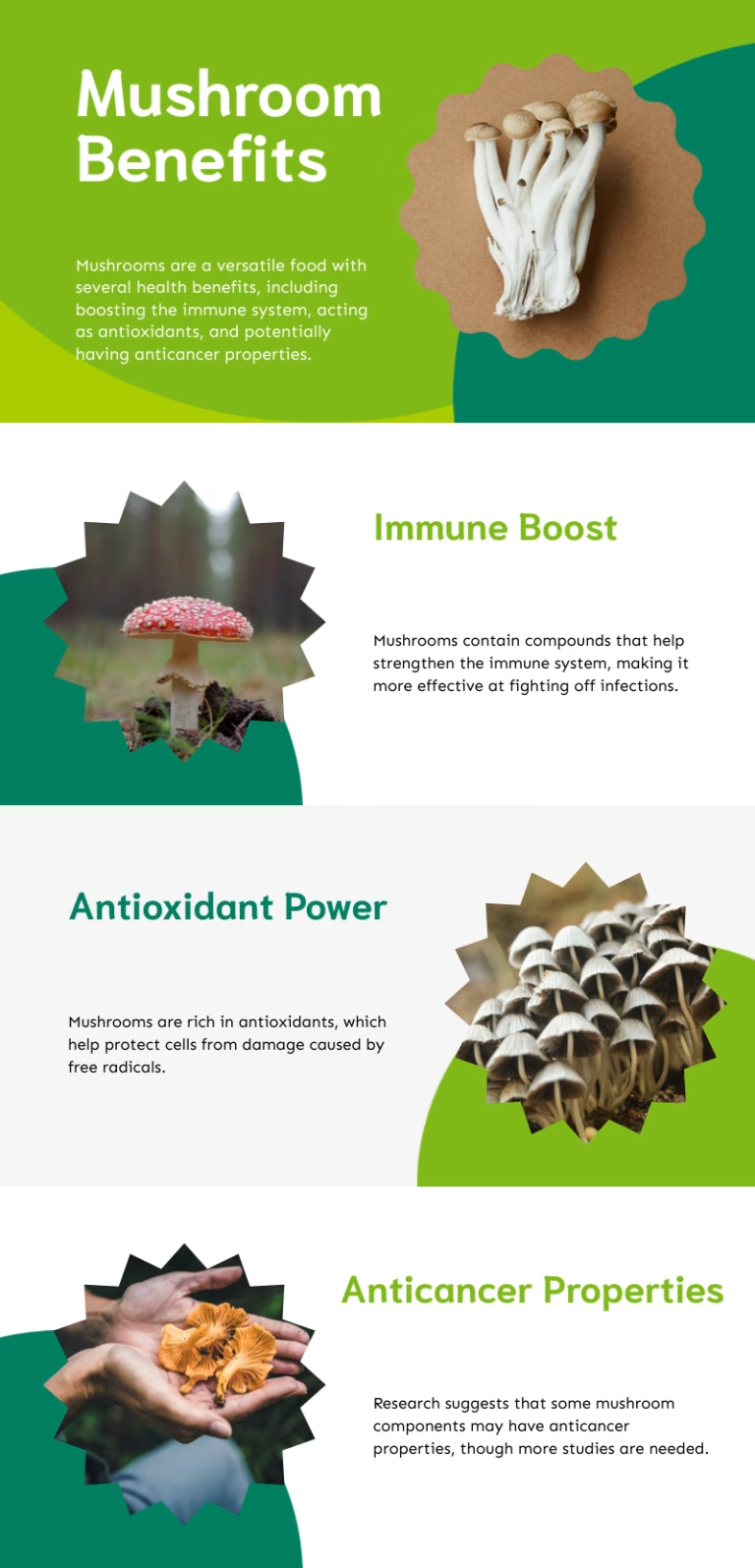
Mushroom Health Benefits:
1. Immune System Support:
All five mushrooms can boost the immune system due to their various compounds, such as antioxidants, beta-glucans, and other immune-enhancing polysaccharides.
2. Antioxidants:
Mushrooms contain antioxidants, which help reduce oxidative stress and may lower the risk of chronic diseases.
3. Anticancer Properties:
Evidence suggests that various mushroom components could have anticancer properties, though more research is needed in human studies. (1)
Here’s a detailed breakdown of cooked individual mushroom nutrition facts and benefits:
How Many Calories Are in Mushrooms?
Here’s a calorie breakdown of the five most common edible mushrooms:
| Mushroom Type | Calories (per 100g) |
|---|---|
| Shiitake | 34 kcal |
| Lion’s Mane | 35 kcal |
| White Button | 28 kcal |
| Portobello | 29 kcal |
| Oyster | 33 kcal |
Mushrooms have naturally low calorie content, making them a great choice for a low-calorie diet.
1. Shiitake Mushroom nutrition facts & benefits
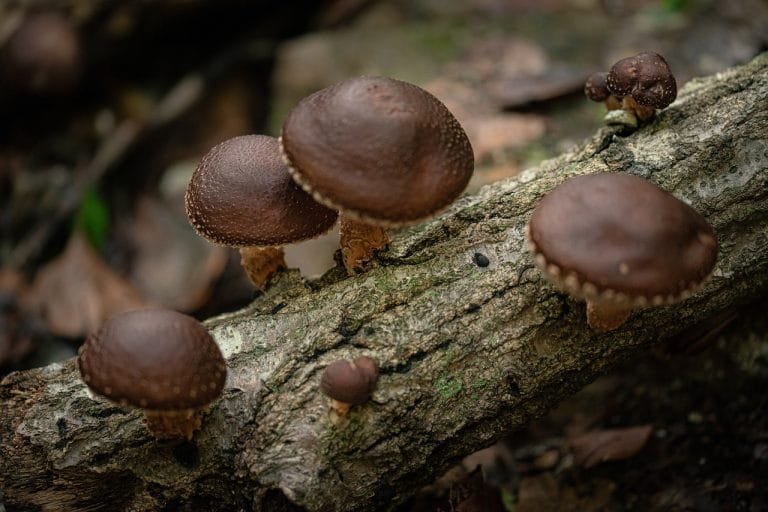
Shiitake mushrooms are not only delicious but also have healing properties. Animal studies have shown that they can help reduce the severity of arthritis (2) and manage fatty liver disease (3). Shiitake mushrooms contain bioactive compounds that can reduce LDL cholesterol levels and fight tumours(4). That’s quite cool for a little fun guy, right?
Shiitake Mushroom nutritional value per 100 grams:
- Calories: 34 kcal
- Protein: 2.24 g
- Fat: 0.49 g
- Carbohydrates: 6.79 g
- Fiber: 2.5 g
- Sugars: 2.38 g
- Vitamin D: Shiitake are especially high in vitamin D, which is rare for plant-based food.
- B Vitamins: They are also rich in B vitamins like B5, B6, and niacin, which help in energy production and brain function.
- Minerals: Contains minerals like copper, selenium, manganese, and zinc.
2. Lion's Mane Mushroom nutrition & benefits
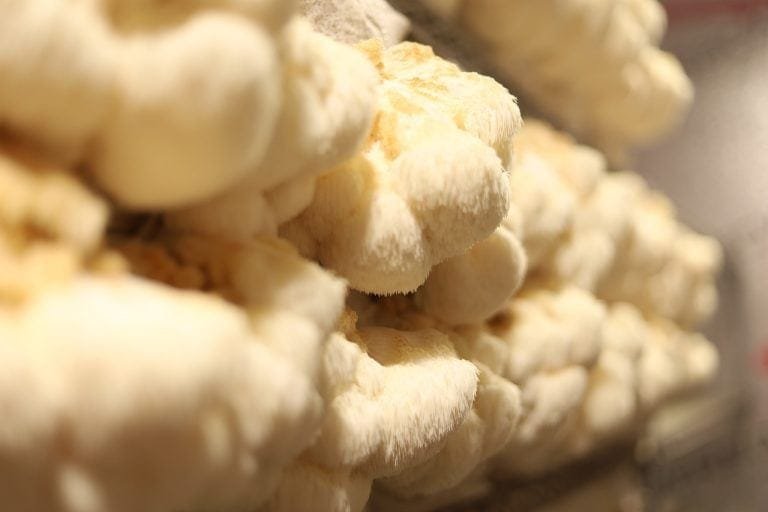
Lion’s Mane is known for supporting brain health. Studies suggest it may stimulate the production of nerve growth factors, which could possibly aid in the prevention of neurological diseases like Alzheimer’s(7), improve mood, gastric and heart health, blood sugar regulation, and even prevent cancer (5).
Lion’s Mane Mushroom nutritional value per 100 grams:
- Calories: 35 kcal
- Protein: 2.2 g
- Fat: 0.5 g
- Carbohydrates: 8.47 g
- Fiber: 0.3 g
- Sugars: 0.3 g
- Vitamins and Minerals: Lions Mane contains small amounts of niacin, folate, zinc, and potassium.
3. White Button Mushroom nutrition & benefits
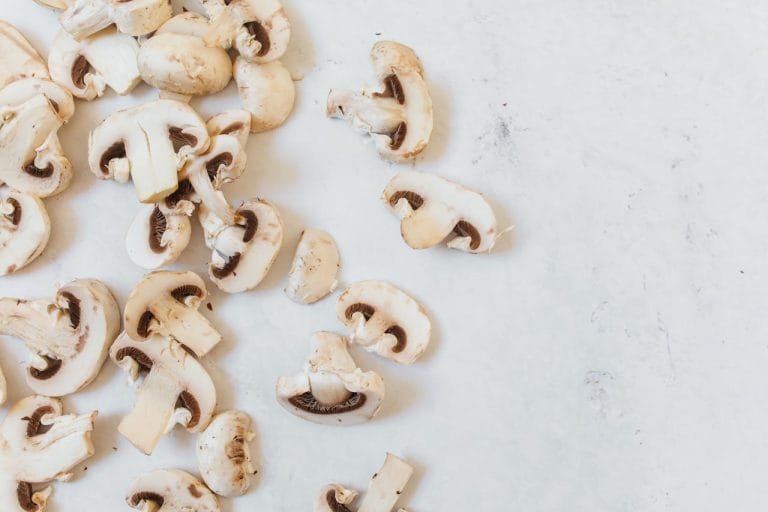
White Button mushrooms are the most common type of mushroom worldwide. Some studies have found that they can reduce the severity of arthritis (2). They are also a good source of dietary fiber, vitamins, and minerals.
White Button Mushroom nutritional value per 100 grams:
- Calories: 28 kcal
- Protein: 3.87 g
- Fat: 0.35 g
- Carbohydrates: 4.26 g
- Fiber: 1.0 g
- Sugars: 2.18 g
- Vitamin D: Significant when exposed to sunlight; important for bone health.
- Selenium: Excellent source, which supports the immune system and antioxidant protection.
4. Portobello Mushroom nutrition facts & benefits
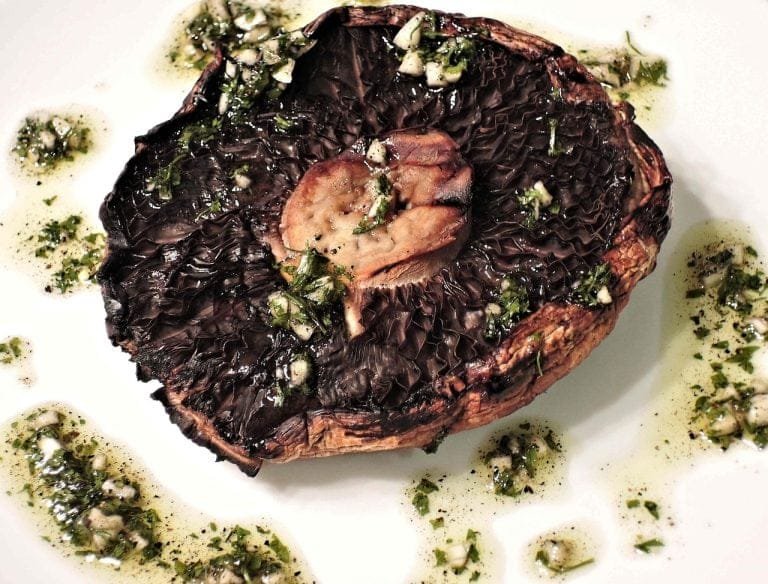
Portobello mushrooms are simply mature versions of Chesnut or Baby Bella mushrooms, which are mature forms of the white button mushroom and share similar nutritional profiles.
Versatility in Cooking: Due to their large size and meaty texture, Portobello mushrooms are often used as a substitute for meat in many dishes, making them a favourite for a healthy plant-based diet.
Portobello Mushroom nutritional value per 100 grams:
- Calories: 29 kcal
- Protein: 3.28 g
- Fat: 0.58 g
- Carbohydrates: 4.3 g
- Fiber: 1.3 g
- Sugars: 2.1 g
- Vitamin D: Significant when exposed to sunlight; important for bone health.
- Selenium: Excellent source, which supports the immune system and antioxidant protection.
4. Oyster Mushroom nutrition facts & benefits
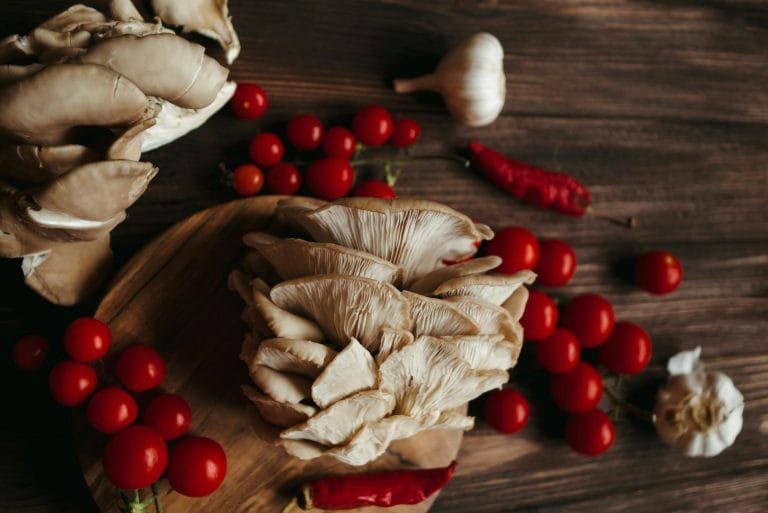
Oyster mushrooms are a good source of protein, vitamins, and minerals and have antibacterial properties (5). In animal studies, oyster mushrooms have been shown to lower cholesterol (8). They also protect against oxidative stress and support overall health.
Oyster Mushroom nutritional value per 100 grams:
- Calories: 33 kcal
- Protein: 3.31 g
- Fat: 0.41 g
- Carbohydrates: 3.57 g
- Fiber: 2.3 g
- Sugars: 0.6 g
- Selenium: Good source, beneficial for antioxidant protection and immune health.
- Vitamin B3 (Niacin): Helps in energy production and brain function.
All 5 mushroom nutrition facts table
To make it easier to compare nutrition facts of all five mushrooms, here is a table:
| Nutrient | Shiitake | Lion's Mane | White Button | Portobello | Oyster |
|---|---|---|---|---|---|
| Calories | 34 kcal | 35 kcal | 28 kcal | 29 kcal | 33 kcal |
| Protein | 2.24 g | 2.2 g | 3.87 g | 3.28 g | 3.31 g |
| Fat | 0.49 g | 0.5 g | 0.35 g | 0.58 g | 0.41 g |
| Carbohydrates | 6.79 g | 8.47 g | 4.26 g | 4.3 g | 3.57 g |
| Fiber | 2.5 g | 0.3 g | 1.0 g | 1.3 g | 2.3 g |
| Sugars | 2.38 g | 0.3 g | 2.18 g | 2.1 g | 0.6 g |
| Vitamin D | High | - | High (when exposed to sunlight) | - | - |
| B Vitamins (general) | Rich | Some (Niacin, Folate) | - | - | - |
| Minerals | Cu, Se, Mn, Zn | Zn, K | Se, P | K, Se | Se, P |
To summarise, all mushrooms are very nutritious, with low calories and fat but rich in proteins, fibre, and essential minerals.
- Calories: The calorie content among mushrooms is similar and low ranging from 28 kcal (White Button) to 35 kcal (Lion’s Mane).
- Protein: Mushroom protein content is quite consistent, with White Button mushrooms highest at 3.87 g and Lion’s Mane the lowest at 2.2 g.
- Fat: All mushrooms are low in fat, with amounts ranging from 0.35 g (White Button) to 0.58 g (Portobello).
- Carbohydrates: Carbohydrate levels vary, with Lion’s Mane’s highest at 8.47 g and Oyster’s lowest at 3.57 g.
- Fiber: Fiber content has more variation, with Lion’s Mane containing significantly less (0.3 g) compared to Shiitake (2.5 g) and Oyster (2.3 g).
- Sugars: Sugars are generally low across all mushrooms, with Lion’s Mane having the least (0.3 g) and Shiitake the most (2.38 g).
- Vitamin D: Shiitake and White Button mushrooms contain high levels of Vitamin D, particularly when exposed to sunlight.
- B Vitamins: Shiitake mushrooms are rich in vitamins B, and Lion’s Mane has some specific vitamin B types like niacin and folate.
- Minerals: mushrooms have several essential minerals , with selenium and phosphorus being common across most mushroom types. Shiitake mushrooms contain a broader range, of minerals including copper, selenium, manganese, and zinc.
Can’t get enough of mushrooms? Check out THE BEST MUSHROOM COFFEE LIST.
5 mushroom health benefits table
| Mushroom | Health Benefits |
|---|---|
| Shiitake | Boosts immune system, promotes heart health, supports bone health |
| Lion's Mane | Improves memory and cognition, aids in digestion, reduces anxiety and depression |
| White Button | Supports bone health, boosts immune system, helps in antioxidant defense |
| Portobello | Regulates blood pressure, protects cellular health, supports weight management |
| Oyster | Boosts immune system, high in antioxidants, supports heart health |
Tips how to get the best out of your mushrooms
How to store Mushrooms:
- Keep them cool and dry: Store mushrooms in the fridge. Because mushrooms can absorb smells, keep them away from foods like onions or garlic.
- Use paper bags: Avoid keeping mushrooms in plastic bags as they can trap moisture and lead to spoilage. Instead, use paper bags which allow the mushrooms to breathe and stay dry.
- Eat them quickly: Mushrooms are best eaten within a few days of buying as they can degrade quite quickly. Check for any signs of spoilage, like slimy surfaces or a sour smell.
Cooking Tips to Preserve Nutrients:
- Avoid washing: Mushrooms absorb water quickly, so instead of washing them under a running tap, wipe them gently with a paper towel. If you have to wash them, do it quickly under running water and cook them as soon as possible.
- Use gentle cooking methods: Steaming, microwaving, or grilling at low temperatures can help preserve vitamins and minerals (9). Overcooking mushrooms can lead to significant nutrient loss.
- Pair with nutrient-preserving ingredients: Cooking mushrooms with ingredients that contain vitamin C, such as bell peppers or lemon juice, can help preserve the vitamins.
- Include the liquid: If mushrooms release water during cooking, add it back into dishes as it contains soluble vitamins and minerals.
Frequently Asked Questions (FAQs)
1. How many calories are in mushrooms?
Mushrooms are very low in calories, ranging from 28 to 35 kcal per 100g.
2. Which mushroom is the healthiest?
All mushrooms provide health benefits, but Lion’s Mane is best for brain health, Shiitake supports immunity, and Oyster mushrooms are rich in antioxidants.
3. Can mushrooms help with weight loss?
Yes! Mushrooms are low in calories, high in fiber, and protein-rich, making them a great addition to weight-loss diets.
To Summarise Mushroom Nutrition facts:
Eating mushrooms can contribute to overall health and may help manage and prevent chronic diseases. With their unique flavours and textures, mushrooms like Shiitake, Lion’s Mane, Portobello, White Button, and Oyster should be incorporated into your healthy diet.
What is your favourite mushroom? Let me know in the comments if I should add any other mushroom nutrition facts to this article.
Please Note: This post is for informational purposes only and is based on research. It’s not medical advice. If you have health concerns, it’s always best to consult with a healthcare professional. Enjoy reading!
If you are interested in science-based nutritional facts, check out these articles as well :
- Antonelli, M., & Donelli, D. (2023). Dietary Consumption of Edible Mushrooms for Disease Prevention: A Literature Overview. Foods 2023. https://doi.org/10.3390/foods2023-15049.
- Chandra, L., Smith, B., Clarke, S., Marlow, D., d’Offay, J., & Kuvibidila, S. (2011). Differential effects of shiitake- and white button mushroom-supplemented diets on hepatic steatosis in C57BL/6 mice.. Food and chemical toxicology : an international journal published for the British Industrial Biological Research Association, 49 12, 3074-80 . https://doi.org/10.1016/j.fct.2011.09.001.
- Chandra, L., Smith, B., Clarke, S., Marlow, D., d’Offay, J., & Kuvibidila, S. (2011). Differential effects of shiitake- and white button mushroom-supplemented diets on hepatic steatosis in C57BL/6 mice.. Food and chemical toxicology : an international journal published for the British Industrial Biological Research Association, 49 12, 3074-80 . https://doi.org/10.1016/j.fct.2011.09.001.
- Chang, F. (2009). Functional properties of edible mushrooms.. Nutrition reviews, 54 11 Pt 2, S91-3 . https://doi.org/10.1111/J.1753-4887.1996.TB03825.X.
- Sutthisa, W., & Anujakkawan, S. (2023). Antibacterial Potential of Oyster Mushroom (Pleurotus ostreatus (Jacq. Ex Fr.) P. Kumm.) Extract against Pathogenic Bacteria. Journal of Pure and Applied Microbiology. https://doi.org/10.22207/jpam.17.3.56.
- David, G., & Williams, J. (2023). Lion’s Mane Mushroom- From Culinary to Medicine. Annals of Innovation in Medicine. https://doi.org/10.59652/aim.v1i2.55.
- Spelman, K., Sutherland, E., & Bagade, A. (2017). Neurological Activity of Lion’s Mane (Hericium erinaceus). , 6, 19-26. https://doi.org/10.14200/JRM.2017.6.0108.
- Bobek, P., Ozdín, Ĺ., & Kuniak, L. (1995). The effect of oyster mushroom (Pleurotus ostreatus), its ethanolic extract and extraction residues on cholesterol levels in serum, lipoproteins and liver of rat.. Die Nahrung, 39 1, 98-9 . https://doi.org/10.1002/FOOD.19950390113.
- Roncero-Ramos, I., Mendiola-Lanao, M., Pérez-Clavijo, M., & Delgado-Andrade, C. (2017). Effect of different cooking methods on nutritional value and antioxidant activity of cultivated mushrooms. International Journal of Food Sciences and Nutrition, 68, 287 – 297. https://doi.org/10.1080/09637486.2016.1244662.
Last Updated: 20/03/2025 by Silvija Meilunaite
Silvija Meilunaite PN1-NC, is a certified nutrition coach and a writer in the nutrition and self-improvement field with a passion for exploring science-based knowledge focusing on holistic health and plant-based nutrition.
Featured in the Wellness on Time magazine.
- S. Meilunaitehttps://barefootbasil.com/author/silvootegmail-com/
- S. Meilunaitehttps://barefootbasil.com/author/silvootegmail-com/
- S. Meilunaitehttps://barefootbasil.com/author/silvootegmail-com/
- S. Meilunaitehttps://barefootbasil.com/author/silvootegmail-com/
